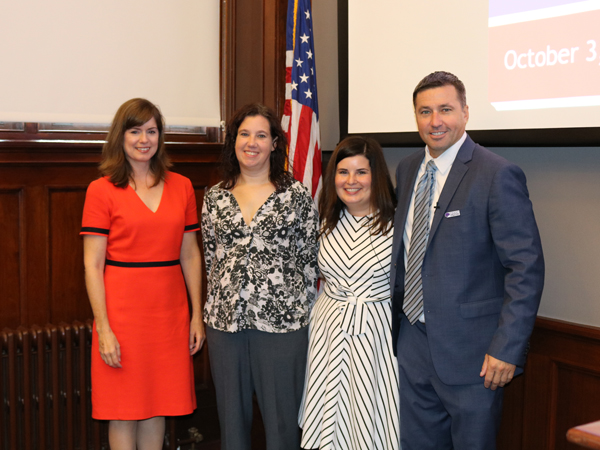From left: Amy M. Miller, Eileen Brewer, Stacey Worthy, and Kevin Lenaburg at Research!America’s congressional briefing on Oct. 3.
(Photo courtesy of Research!America)
By Ansley Waters, SWHR Science Programs Intern
Eileen Brewer has lived with migraine symptoms almost every day for the past 28 years. She spent six years getting her college degree, only to realize when she started working that her chosen profession was not “migraine-friendly” as it involved looking at a computer screen all day.
“At the time, I didn’t know as much about my disease as I do now, and there really wasn’t anybody to educate me either,” she said. “I had to discover my limits on my own.”
Brewer’s struggles as a migraine sufferer in the workplace are not unusual. To draw attention to the importance of workplace accommodations for employees with migraine, advocacy group Research!America hosted a congressional briefing on Oct. 3 featuring Brewer, a patient advocate; Society for Women’s Health Research President and CEO Amy M. Miller; Stacey Worthy, legal counsel for the Aimed Alliance, and Kevin Lenaburg, executive director at the Coalition for Headache and Migraine Patients (CHAMP).
Migraine is an incapacitating neurological disorder that affects about 47 million Americans. It is three times more common in women, who also tend to have longer, more intense migraine attacks and additional risk for associated comorbidities compared to men.
Migraine attacks are not simply headaches. They may include symptoms like nausea, vomiting, dizziness, aura, impaired mobility, and pain in the face, head or neck. Migraine costs the U.S. around $78 billion annually, largely due to lost productivity.
Research on migraine has been notably underfunded relative to the burden of disability it causes, creating knowledge gaps about migraine etiology, triggers, and treatment options. “We have a lot of basic science to do,” Miller said, citing the traditional absence of female animals in migraine research as a concern. This lack of migraine research has disproportionately affected women, due to their higher disease prevalence and severity.
SWHR recently published a report in the Journal of Women’s Health that identifies gaps for migraine research, care, and education, and states that future research must address sex differences in order to improve health outcomes for both men and women.
Miller also emphasized that overcoming the stigma around “invisible” painful conditions like migraine will take concentrated policy efforts driven by research, as “science should drive policy because policy drives change.”
There are many reasonable changes that employers can make in order to best support their employees with migraine, Brewer said. “Migraine patients want to work,” she added. “We don’t want to spend hours and days in a dark room.”
Brewer described some relatively simple and cost-effective accommodations, such as having an office quiet room and a fragrance-free workplace, allowing special glasses and noise-cancelling headphones to be worn, providing screens for bright computer monitors and shades for windows, and permitting flexible work schedules.
Increasing research funding for migraine and implementing reasonable workplace accommodations are just a couple of examples of the research and policy changes that need to occur to address the substantial burden that migraine has on individuals and society.
For more information on migraine, please visit the SWHR Migraine Network Page.
